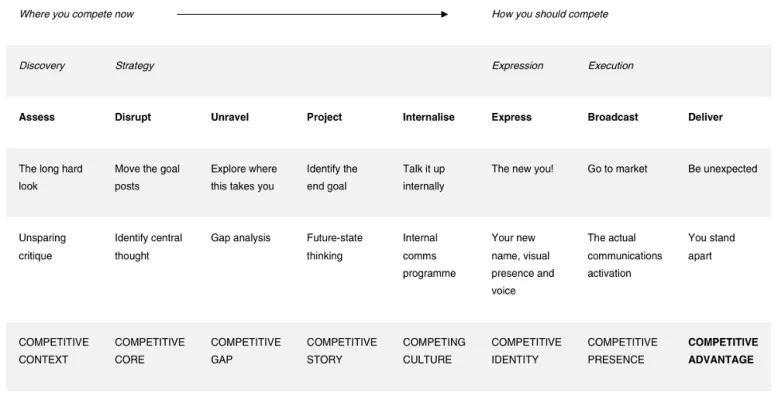Today, everyone competes everywhere
We all compete for attention, market share, the customers we have, the customers we want, share of mind, share of wallet, margin, volume, investors, employees, suppliers, dividend levels, media attention, distribution, preference, loyalty, top line growth, return on capital . . .
And that’s important, because the need to compete helps ensure that customers receive the best they can get from the market. It also gives investors and employees proper choice, and stimulates opportunities to make genuine decisions.
Two choices
The speed and demands of a market-driven economy generate stark choices for every participant:
- Compete like everyone else
- Compete to your strengths and your agenda, and inspire your stakeholders to re-expect
The first choice is easier – but it doesn’t work
Compete like everyone else
You’re part of the crowd. You look, feel, sound, taste and sell just like everyone else. In such an environment, no-one really achieves distinction. Mostly they fight for survival and the hope of recognition. A face in the crowd – with a logo. And price becomes the only competitive tool.
The second choice is much harder – but it works
Compete as a brand and inspire your stakeholders to re-expect
You choose to compete as a true differentiated brand: to take a position in the marketplace that is distinctive, targeted, disciplined, directly aligned to your directions and aspirations as a business, and that has powerful appeal. This requires you to make a commitment to that position and to explore its implications for your competitive advantage.
What do we mean by ‘brand’?
Your brand is the sum total of what you mean to each of your stakeholders – real or imagined.
But . . .
Astute brands have ownership of how they engage stakeholders. They know what they want to mean to stakeholders and that feeling is established and reinforced every time a customer, investor, employee or member of the community interacts with the brand. This consistency of experience and impression across all touchpoints works like compound interest, building an ever stronger, deeper and more loyal relationship. But it takes strict, intentional planning and control.
How to plan for competitive advantage with your brand
Start by capturing and articulating not just who you are as a competitor, but where you compete, why that fits with your business agenda, how you can focus your people to go there with you, and what that will mean for stakeholders.
To ensure these assessments are made objectively, it may be wise to engage a competent brand consultant to manage the process.
Next, look at all four of your major stakeholder interfaces:
- Customers – why the people you want to have as customers will prefer to buy from you: what you offer them, why that excites them, why it differentiates you, what they receive in return for their loyalty.
- Investors – why you stack up as a competitive investment decision: your track record, your reputation, your vision, the numbers behind your direction, your standing in the market, the returns you represent, your sustainability as a business.
- Employees – why your people will want to work with you: your cause, your values, where they’re going, what’s in it for them, what’s expected of them, and how they will be recognised and rewarded for the contributions they make.
- Community – the standing you enjoy in the wider community, and the opportunities you have to focus public opinion through sponsorships, learning programmes, interactions with NGOs etc.
Seek to generate five intangible emotive outcomes . . .
- Strong perception – the people you interface with have a powerful sense of not just who you are, but also what you stand for.
- Consistent reputation – the ways you behave as an organisation, the things you do, the products and services you offer and the media coverage you receive confirm their perceptions.
- Real relevance – customers have reasons that are very real to them for choosing you; investors believe you actively contribute to their goals; employees see a real place for themselves with you; the community enjoys the opportunities you generate beyond the workplace.
- Long lasting affinity – your stakeholders have an opinion of you that aligns with what they believe they’re looking for, and that makes them feel differently about you than they do about your competitors.
- Quantifiable prestige – all the above help make you ‘special’ in their eyes. They’ll be more loyal to you, more forgiving of you, more eager to consolidate their relationship, and prepared to pay more because of the emotional payback they receive.
. . . because they deliver seven tangible business outcomes
- A strongly defined sense of purpose – who you are, where you’re going and why you’re different. This not only strengthens your relationships with stakeholders, it also provides valuable guidance for your ongoing business strategy.
- A clearer market position – you don’t just look and feel like everyone else. As a result, the market tends to judge them by you and not the other way around. It also provides you with a much clearer understanding of who your real competitors are, and could be.
- Higher profitability – a number of surveys have indicated that companies with distinctive brands can expect to command a significant premium over their look-alike competitors in terms of their margins.
- Less staff churn – strongly branded companies with well aligned cultures can see a meaningful reduction in their employee churn rates.
- Greater customer loyalty – strong brands retain their customers and grow the amount that customers spend with them. As a result, you can expect to see a significant drop in customer turnover rates.
- Committed workforce – companies with well-aligned cultures tend to see a marked improvement in their internal health, with less silo-ing, higher productivity and better overall responsibility taking.
- Deeper value – intangibles such as brand equity, intellectual property and goodwill now account for an increasing share of a company’s perceived overall value. One report suggested that well-branded listed companies can enjoy a substantial earnings premium over similar companies with poorer brands.
Making the shift to competitive advantage
Undertaking an intentional competitive brand positioning does require serious commitment, sustained effort, total management buy-in, and to be honest, real branding nous.
To provide a glimpse of the sort of process needing to be undertaken, here’s a high level roadmap. But, of course, each step here is only the top line. Beneath each a detailed and comprehensive programme of components is required.

A rebrand journey of this rigour will be very core to your future state and your essential business strategy, so before you embark on such a ground-moving exercise the big question that needs to be answered is what degree of commitment you’re prepared to undertake. Do you continue to compete like everyone else, or make the commitment to compete to your strengths and your agenda, and inspire your stakeholders to re-calibrate their expectations of what you can deliver for them?

